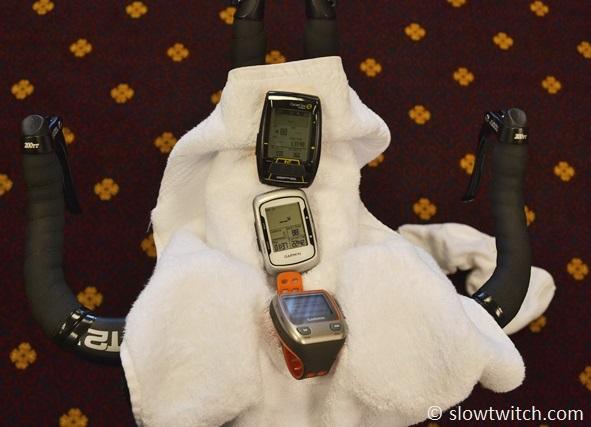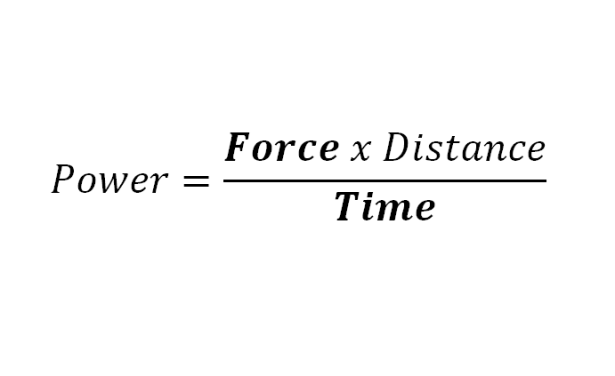Pioneer Power System
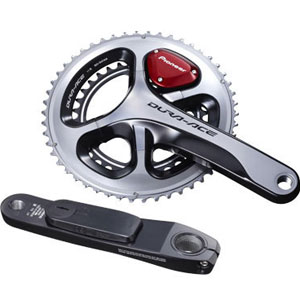
The Pioneer SGY-PM910H is the updated model (Generation 2) of Pioneer's crank based power meter. For those not familiar with this compelling product, it measures power every 30 degrees during a complete pedal rotation on both the left and right side allowing for true left-right power metrics, along with many other advanced metrics.
The Generation 2 model maintains all the same metrics but in a more refined, cleaner, and less expensive set up. Pioneer listened to consumer feedback on its first version and eliminated the use of zip-ties; refined the power system; and significantly reduced the price. The SGY-PM910H comes with two covers, metallic red and metallic silver, and they are easily switched.
It is only available for the Shimano Dura-Ace ($1800) and Ultegra cranksets ($1500) in all the same available chainring and crank arm lengths offered by Shimano. This price includes the crank, making this a highly competitive system as go crank-based power meters. Those who already own an Ultegra 6800 or Dura-Ace 9000 can send their crankset to Pioneer and within 7-10 business days the SGY-PM9100c will be professionally installed for $1299.
Pioneer includes true left/right power along with some of the most advanced cycling metrics currently available including: true left/right power, pedal smoothness and efficiency, force vector, tangential force, etc.
The Pioneer power meter weighs in at around 70 grams, which includes the sensors and magnets for both the right and left arm. It uses a replaceable CR2032 battery for each arm and lists a lifespan of 180 hours, noticeably less than Quarq's 300 hours. A nice addition with Pioneer's Cyclo-Computer is that you can monitor the battery power for each sensor when you conduct a zero calibration. The SGY-P910H also uses the standard waterproofing of IPX-6/IPX-7 found on many other power meters. I rode a couple of times in wet conditions and noted no issues with either the power meter or Cyclo-Computer.
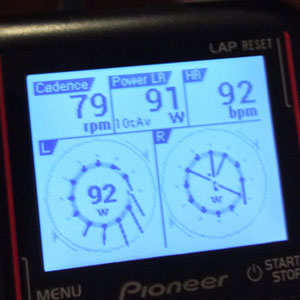
The use of the two magnets contrasts with Quarq's elimination of the magnet requirement. However, in order to get accurate readings every 30 degrees it is required with the Pioneer system. I've heard some people have had problems with Quarq magnets coming off, so something to keep in mind. During one of my rides, I had a major chain drop that was a good test for the magnet. It remained but it was scuffed a bit. I do recommend ordering a spare magnet at time of purchase, just in case.
The install on my Specialized Shiv and pairing to the Cyclo-Computer CA500 was simple and quick. I didn't find the install and pairing any more time consuming than on my Quarq. In fact, I found the magnet placement and install a bit easier with the use of their Youtube video and the use of a small light on the crank and the opposite crank arm to indicate a proper placement. Of note, although the SGY-P910H is nearly universal with any frame, it's best to confirm prior to a purchase due to clearance with the chain stay and crank arm on some models.
The pairing to the CA500 computer, or any Ant+ computer (in my case Garmin Edge 500), was just a push of a button. The only additional step with the CA500 computer was to pair both the left and right sensor.
Once installed and paired, the CA500 computer picked up the power meter as fast as my Garmin Edge. The Pioneer system uses a zero point calibration and L/R sensor calibration that was a simple touch of the screen on the CA500. The L/R sensor calibration only required the crank-arm to be perpendicular to the ground. If I noted a false/irregular reading from the opposite leg when doing single-leg pedaling, a quick calibration corrected this each time.
The power meter also has a memory feature so after using the zero calibration a couple times, it will remember your environment and automatically respond to changes. A recent update to their analysis software, Cyclo-Sphere, actually shows this information, a nice addition.
The speed and amount of the data collected by the Pioneer power meter was easily seen on the first ride. I typically use the 3-second average for my power metric, but it fluctuated too much so had to switch to either 5- or 10-second to smooth out the data a bit more. It instantly detected when you increased power without any lag due to the multiple readings it takes during the complete pedal stroke. To be honest, I never realized the length of delay with my Quarq until I did my first set of power intervals with Pioneer system.
Pioneers states its accuracy is at +/- 2% and the power readings appeared to be within this range compared to my S-works Quarq and my Wahoo Kickr without any notable signs of drift due to temperature (Note: I always find a 10 Watt difference between my Kickr and any power meter). More importantly, it was consistent over multiple rides. So what distinguishes the Pioneer power meter from other crank based power meters on the market? Simple, data, data, data.
If you are a dedicated triathlete (defined as reading ST forums everyday and know that shaving saves you 15 watts) then you are probably going to enjoy analyzing the advanced metrics provided by the Pioneer system. The debate will be if they are of any value.
There is always discussion on the value L/R power, pedaling efficiency, or what is the best cadence. I believe as systems such as Pioneer's become more commonplace, tested, and understood, they will be just as valuable as a power meter in improving cycling ability and efficiency. In fact, if we accept Pioneer's definition of pedaling efficiency, each individual could answer the question of what is his ideal cadence for each power zone based on this metric, one of the many charts available on Pioneers Cyclo-Sphere. I enjoyed testing how pedaling efficiency and smoothness were all affected by fatigue, cadence, power levels, and changes in bike fit.

For example, I noted a 9% swing (30 Watts for me) in power balance from workout to workout, depending on factors such as leg fatigue, workout prior to the ride, and other variables. This realization makes me reluctant to recommend a single leg power system if one could afford otherwise.
I was also able to show a threshold ride to my Specialized BG bike fitter (whom I have been using for the past 2 years ) who looked at the various metrics on my pedal stroke and was able to make a fit adjustment, that corrected a dead spot in my pedal stroke. Through ongoing analysis and instant feedback during the fit adjustment, I was able to instantly improve pedalling efficiency (1% increase) and improve my L/R power balance. These minor improvements resulted in an immediate increase in power (nearly 5%) in my 1 min, 3 min, 5 min, and 20 min peak power (N=1). I look at these increases as free speed as it was a function of an improved pedal stroke, an inefficiency that may have gone unnoticed with the ability to analyze these metrics. It also opened up my training to improving my pedal stroke and relying on the instant feedback provided by the CA500 to monitoring the force vector while doing single-leg drills.
Overall, like most triathletes I know, I am a fan of collecting as much data/metrics as possible. The metrics available to analyze are immense with this system and require an understanding of not only what the metrics mean but what to do with them. It will be interesting to evaluate how athletes, coaches, and bike fitters learn to interpret and take advantage of these metrics to improve performance on the bike, and on the run.
The only criticisms, albeit small, with this system is that it is only available for Shimano cranksets, and the only computer that can collect all of the metrics collected by the Pioneer power meter is Pioneer's CA500 Cyclo-Computer.
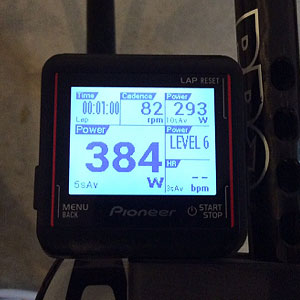
Pioneer Cycle-Computer (SGX-CA500)
The SGX-CA500 is one of the two cycling computers made by Pioneer designed for use with the Pioneer power meter, with the CA900 being their colour/high end model. It works on Ant+ and Ant+++ (I will explain this shortly). It has a highly customizable/readable display that measures 58mm x 58mm, uses a resistive touch screen display, WiFi uploading, fast GPS acquisition, temperature, barometric pressure, a 4GB flash memory, weighs 75 grams, allows for six bike profiles, and is currently the only cycling computer on the market capable of capturing all the data collected by the Pioneer meter. It comes with a USB charging cable and an out-front mount but this will not work with aero bars and you will be required to purchase either the Pioneer TT mount or K-Edge.
The CA500 display will allow you to monitor up to nine data points at once over six data screens that only require a finger swipe to switch. I found that five to six data points was the ideal number as the numbers get smaller as you increase to nine data points. You do have the option to zoom-in (will fill screen) on any metric by touching the screen and zoom out by touching the screen again. Since the CA500 only requires a finger swipe to switch screens, this may be the more practical option than zooming in on a single metric.
I must admit the early software versions for the touchscreen left a bit to be desired, but Pioneer has done a great job fixing this issue in recent software updates. It is not quite iPhone quality, but was vastly improved and worked quite well, even in wet conditions. The backlit screen on the CA500 worked great and made reading the screen very easy under different light conditions.
The WiFi feature worked quite well and allowed you to save and select multiple WiFi networks for instant uploading. The initial setup of the WiFi may be a bit of a headache if you have a long WiFi password as it must be set up using the CA500 which doesn't have a QWERT keypad. However, once setup, the CA500 can upload your completed ride or workout via your WiFi network within seconds to Cyclo-Sphere where it can also be set to push the data to Strava or TrainingPeaks.
The CA500 can also update its software via the same WiFi network. I updated the software three times and each time it took approximately 10-15 minutes (depending on WiFi speed) without any issues. There is also status screen to let you know the time remaining. Currently, you need to sign in to Cyclo-Sphere to know that an update is available but, in the future, we may see the CA500 advise that an update is available. For those without WiFi, you can still do all of the above via a USB cable which is also used for charging the CA500.
The battery life for the CA500 is listed at 12 hours and appears to be accurate based on my experience, about 5-8hrs to less than the Garmin 500 series. The charge time was between 3-4 hours for a full charge and has a 'boost' charge option that allows for a reported faster charge.
The CA500 worked well with other Ant+ devices (e.g., speed, cadence, HR sensors) without any issues but its true value is when paired with the Pioneer power meter through its own transmission protocol (Ant+++). CA500 is the only cycling computer on the market that can capture all the advanced metrics transmitted by the Pioneer Meter including true L/R torque, power, force, amongst other data points (Note: soon to be added is Di2 information). The amount of data and speed required Pioneer to use this protocol as Ant+ could not.
Since the CA500 does not have Bluetooth capabilities, nor does the Pioneer power meter, all of the mobile options available in some other cycling computers are not available (e.g, live tracking, text notifications, Strava route notifications, etc). Needless to say all other Bluetooth sensors will also not work with the CA500 without the use of a secondary device (e.g., Viiii, Mio Velo?).
Pioneer and K-Edge each have TT mounts that are compatible with the CA500 as the road mount will not work. The Pioneer TT mount comes in about $20.00 cheaper and 10 grams less than the K-Edge and I found the Pioneer TT mount to be the better of the two regardless.
There are a couple of minor things that I wish the CA500 did a bit differently or added, primarily: the lap button location, IF/NP/VI data, and the computer mount.

Although the high-end CA900 has the lap button on the front of the computer, the CA500 has it on side which makes it difficult to use with aero bars; however, you can set up automatic laps like most other cycling computers. With the overwhelming amount of metrics it captures, Intensity Factor (IF), Normalized Power (NP), and Variability Index would have been nice. The CA500 has a special mounting bracket which means it does not play well with most BTA setups and will require some creative use of zip-ties or electrical tape. The Pioneer TT mount worked great but if you are already set up with BTA mount (e.g, XLab Torpedo Mount), you will need to improvise.
Overall, the CA500 is a solid standalone cycling computer and at a $379 price point for a bundle (CA500 with speed/cadence and heart rate), it is well positioned; but it truly shines as part of the total Pioneer system.
Cyclo-Sphere
The Pioneer power meter and Cyclo-Computer work symbiotically with cyclo-sphere.com to take full advantage of the advanced metrics collected by the Pioneer system. Cyclo-Sphere is highly customizable, free online platform for cycling. It performs best with the Pioneer system but does allow for traditional power analysis with other types of power meters, similar to what can be done within TrainingPeaks. However, when you use the Pioneer system (power meter and computer), it performs every possible power analysis you could imagine. It is a bit like Apple: There is a chart for that.
The basic workout screen (above) provides all the traditional information including your critical power; however, Cyclo-Sphere allows you to further dissect the data into 30 degree increments, for either your left, right, or both legs, and analyze your pedalling efficiency, Force Vector Analysis, Torque Analysis, Pedal Smoothness, etc. It pretty well does everything outside of calculating your CdA or Crr.
The metrics and possible analysis can be overwhelming but there is quite a bit of information found within their system. I found that I spent most of my time creating customized charts for the metrics that I found to be important.
Cyclo-sphere allows you to name and customize charts for pretty well every piece of data collected, and to analyze over customized time periods, or selected workouts. For example, you can select your past X number of FTP tests and then select your pedaling efficiency/power balance (for either pedal) and your power weight ratio to see how any of the above may affected your FTP. Below is a chart I created to monitor my pedaling efficiency at Z1 to Z7 and power balance at Z1 to Z7 over a couple of weeks. It truly is endless.
Pioneer is continuing to develop this system and a means of best utilizing and interpreting the collected data with the aid of Pro Riders and Hunter Allen.

Cyclo-Sphere is solely meant to analyze and log cycling metrics, so it best works independently of other systems such as TrainingPeaks. However, it can be set for auto-forwarding data to TrainingPeaks and Strava, the same types of data uploaded from other power meters.
In conversations with Pioneer, they will be continuing to try to lead the data side of power meters. A couple of interesting ideas that we may see in the future are the ability to overlay rides and — with the soon-to-be Di2 integration — the ability to analyze power, cadence, heart rate, efficiency, and time spent on a specific gearing during a ride.
Final Thoughts
I think it is best to evaluate Cyclo-Sphere, CA500, and the Pioneer power meter as an integrated system. If we evaluate each component on its own (with the exception of the power meter), each is good but none may stand out. However, as a complete system (CA500, Cyclo-Sphere, and the Pioneer Generation 2 power meter): Wow!
It is leading the way in advanced cycling metrics, yet at the same price point for similar crank-based power meters currently available. Pioneer's push into the power meter market with this system should find a niche with those interested in advanced cycling metrics with a top of the line crankset.


